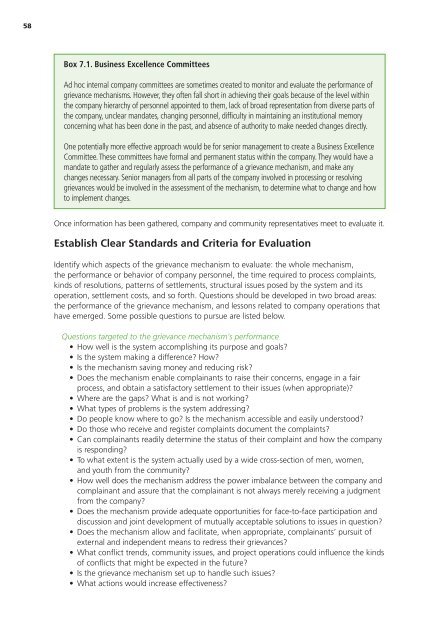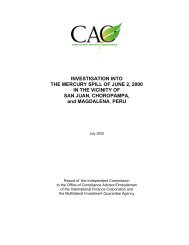A Guide to Designing and Implementing Grievance Mechanisms for ...
A Guide to Designing and Implementing Grievance Mechanisms for ...
A Guide to Designing and Implementing Grievance Mechanisms for ...
You also want an ePaper? Increase the reach of your titles
YUMPU automatically turns print PDFs into web optimized ePapers that Google loves.
58<br />
Box 7.1. Business Excellence Committees<br />
Ad hoc internal company committees are sometimes created <strong>to</strong> moni<strong>to</strong>r <strong>and</strong> evaluate the per<strong>for</strong>mance of<br />
grievance mechanisms. However, they often fall short in achieving their goals because of the level within<br />
the company hierarchy of personnel appointed <strong>to</strong> them, lack of broad representation from diverse parts of<br />
the company, unclear m<strong>and</strong>ates, changing personnel, difficulty in maintaining an institutional memory<br />
concerning what has been done in the past, <strong>and</strong> absence of authority <strong>to</strong> make needed changes directly.<br />
One potentially more effective approach would be <strong>for</strong> senior management <strong>to</strong> create a Business Excellence<br />
Committee.These committees have <strong>for</strong>mal <strong>and</strong> permanent status within the company.They would have a<br />
m<strong>and</strong>ate <strong>to</strong> gather <strong>and</strong> regularly assess the per<strong>for</strong>mance of a grievance mechanism, <strong>and</strong> make any<br />
changes necessary. Senior managers from all parts of the company involved in processing or resolving<br />
grievances would be involved in the assessment of the mechanism, <strong>to</strong> determine what <strong>to</strong> change <strong>and</strong> how<br />
<strong>to</strong> implement changes.<br />
Once in<strong>for</strong>mation has been gathered, company <strong>and</strong> community representatives meet <strong>to</strong> evaluate it.<br />
Establish Clear St<strong>and</strong>ards <strong>and</strong> Criteria <strong>for</strong> Evaluation<br />
Identify which aspects of the grievance mechanism <strong>to</strong> evaluate: the whole mechanism,<br />
the per<strong>for</strong>mance or behavior of company personnel, the time required <strong>to</strong> process complaints,<br />
kinds of resolutions, patterns of settlements, structural issues posed by the system <strong>and</strong> its<br />
operation, settlement costs, <strong>and</strong> so <strong>for</strong>th. Questions should be developed in two broad areas:<br />
the per<strong>for</strong>mance of the grievance mechanism, <strong>and</strong> lessons related <strong>to</strong> company operations that<br />
have emerged. Some possible questions <strong>to</strong> pursue are listed below.<br />
Questions targeted <strong>to</strong> the grievance mechanism’s per<strong>for</strong>mance<br />
• How well is the system accomplishing its purpose <strong>and</strong> goals?<br />
• Is the system making a difference? How?<br />
• Is the mechanism saving money <strong>and</strong> reducing risk?<br />
• Does the mechanism enable complainants <strong>to</strong> raise their concerns, engage in a fair<br />
process, <strong>and</strong> obtain a satisfac<strong>to</strong>ry settlement <strong>to</strong> their issues (when appropriate)?<br />
• Where are the gaps? What is <strong>and</strong> is not working?<br />
• What types of problems is the system addressing?<br />
• Do people know where <strong>to</strong> go? Is the mechanism accessible <strong>and</strong> easily unders<strong>to</strong>od?<br />
• Do those who receive <strong>and</strong> register complaints document the complaints?<br />
• Can complainants readily determine the status of their complaint <strong>and</strong> how the company<br />
is responding?<br />
• To what extent is the system actually used by a wide cross-section of men, women,<br />
<strong>and</strong> youth from the community?<br />
• How well does the mechanism address the power imbalance between the company <strong>and</strong><br />
complainant <strong>and</strong> assure that the complainant is not always merely receiving a judgment<br />
from the company?<br />
• Does the mechanism provide adequate opportunities <strong>for</strong> face-<strong>to</strong>-face participation <strong>and</strong><br />
discussion <strong>and</strong> joint development of mutually acceptable solutions <strong>to</strong> issues in question?<br />
• Does the mechanism allow <strong>and</strong> facilitate, when appropriate, complainants’ pursuit of<br />
external <strong>and</strong> independent means <strong>to</strong> redress their grievances?<br />
• What conflict trends, community issues, <strong>and</strong> project operations could influence the kinds<br />
of conflicts that might be expected in the future?<br />
• Is the grievance mechanism set up <strong>to</strong> h<strong>and</strong>le such issues?<br />
• What actions would increase effectiveness?





